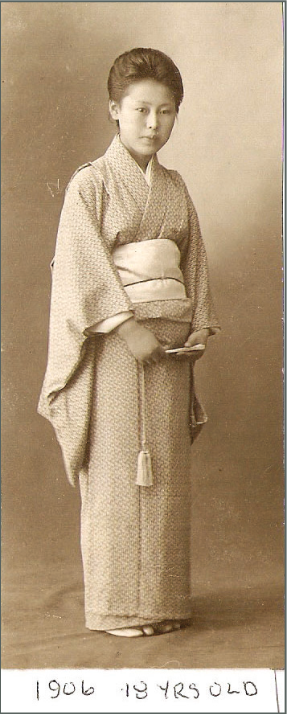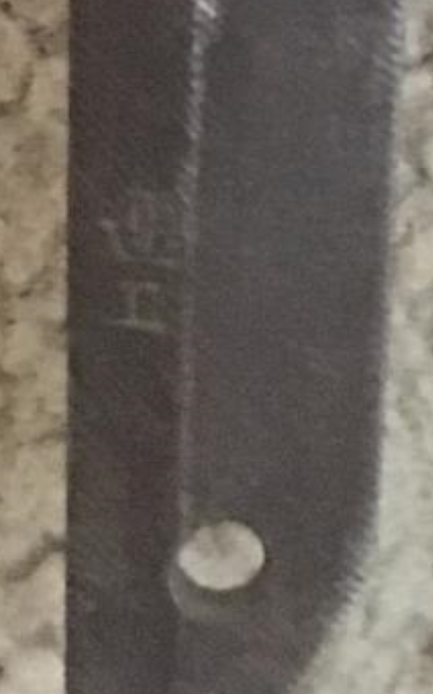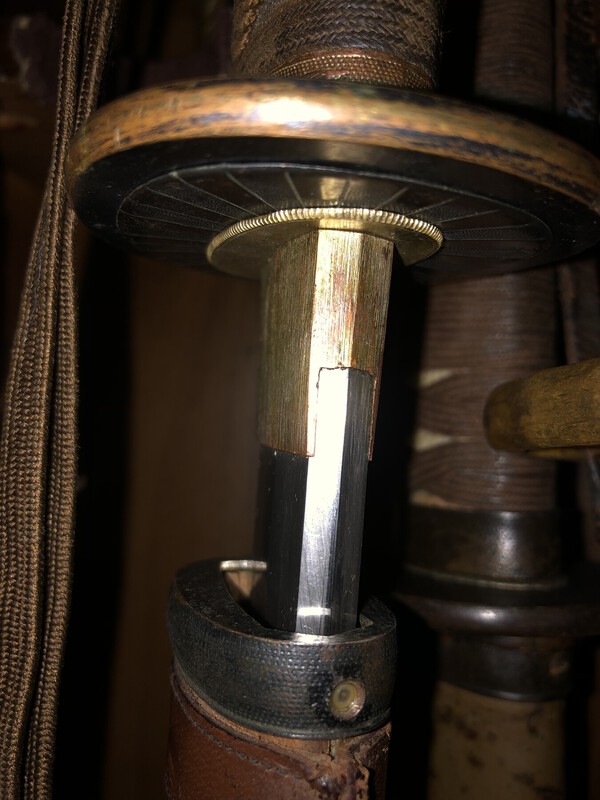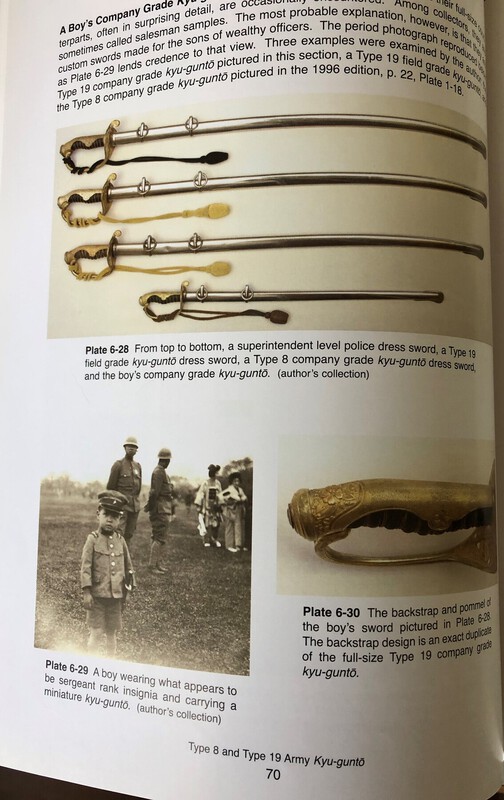-
Posts
13,036 -
Joined
-
Last visited
-
Days Won
155
Content Type
Profiles
Forums
Events
Store
Downloads
Gallery
Everything posted by Bruce Pennington
-
Interesting observation Trystan! Neil, I see yours is made the same way, and they even painted the thickened center the burnt red color as they would the boar's eye seppa. I hate to sidetrack the thread, but wasn't there a thread, Neil, where you explored the purpose of that metal loop? I tried a search but, alas, you know how bad I am at searches. My follow-on question is "Are these loops only found on Iada-made fittings?"
-
Thank you Thomas! I had one, but this one is a much better picture (plus, while switching them, I noticed I spelled Sadaroku wrong!). Now updated.
-
Well, if it had been a snake it would have bitten us! I just checked Fuller's picture of it, and it is right there for all to see, as well. I've updated the Stamps doc to reflect this (5.4). Nice work Neil!
-

Showa Wakizashi with arsenal stamp?
Bruce Pennington replied to Brian's topic in Translation Assistance
I wish it were dated. We have 1 Showa stamped blade from 1935. The rest are 1938 and beyond. -

Shin Gunto Katana mei help needed
Bruce Pennington replied to Brian's topic in Translation Assistance
Brian, Does the blade appear to be traditionally made or not? There is a faction that still believe that the Seki Guild stamp was not always one of the Army mandated stamps, but simply a Guild mark. In fact, Ohmura states the guild was using the stamp before the law mandating stamps. This stamp is way more precisely made than any I've seen. Could this blade possibly be one of the pre-mandatory-stamp era and gendaito? -

Showa Wakizashi with arsenal stamp?
Bruce Pennington replied to Brian's topic in Translation Assistance
I agree that it's a partially struck Sho stamp. -
Three nice examples here: Patent on Tabs Including the Fuller & Gregory page on them. Couple more HERE. And one HERE.
-

Attention Mantetsu Owners: A Survey
Bruce Pennington replied to Bruce Pennington's topic in Military Swords of Japan
That's really sad. They're still not as good as those coming out of Japan, though, through Komonjo. Still, some people are going to get burned. -
Not to side-track your topic Matt, but thought this picture was interesting. A young woman in 1906. I think the tassel is hanging off the end of a fan, but it's hard to tell. Just found it interesting that tasseled cords were a thing before the military started using them. Might even explain some strange tassels that show up on bring-home swords.
-
Dave, I couldn't find your F&G page, but here's the Dawson pages showing your exact sword as a Police Lt's sword. The 16 ray emblem is Lt & Superintendent of police, and you are correct about the 5 petal sakura being police. Edit: Ah! I found the page in Fuller's 1987 ed. His 1996 edition is more up-to-date, as is Dawson's book published in 2007. I keep the '87 F&G because it still has a few items not found in the other two books, but you'll find more out-dated info in it.
-
Thanks Peter, interesting article! Most of the dated correspondance he discussed can actually be found here in the member articles: WW2 US Govt Archived Documents He states 569,013 swords were collected, compared to Fuller's citation of Allied estimates of 661,621, though Fuller's number is of "swords and sabres taken in the south-west Pacific and Japan." Fuller's personal estimate at the real number "exceeds 2,000,000", compared to Kono's 3,000,000. So both sources are in the same ballpark of each other and serve to verify the vast numbers taken. It is interesting to see how many times the Allies flip-flopped between "take them all" and "ok, let them keep the art/treasure swords", but that isn't surprising considering the multitude of controlling agencies, various commanders involved, and turf-war mentalities that can be involved in organizations of any size.
-

Manchurian Rinji Seishiki Sword
Bruce Pennington replied to IJASWORDS's topic in Military Swords of Japan
-
A question was raised on another forum about the habaki style being "squared off". I checked my meager collection and all have the extended sides. The only squared off habaki I have is on a post-war souvenir sword. Could this be a sign that the sword was Chinese made? Or were there legit Japanese habaki without the gap at the mune? Pictures of mine. I saw that the Navy habaki have smaller gaps than army, but they are all gapped. Last one is the Souvenir Sword
-

Manchurian Rinji Seishiki Sword
Bruce Pennington replied to IJASWORDS's topic in Military Swords of Japan
Forgot this thread was started. I'm copying my post from the other thread: Couple of updates on this: 1. Trying to find anyone, either here or on Warrelics, that has documentation or insight to the 連工, or Renkoh stamp (got the English pronunciation from Nick). I'm starting to agree with Thomas (Kiipu) on the idea this was a contraction, like Mantetsu is for SMR, for the 大連鉄道工場 Dairen Tetsudō Kōjō Dairen Railway Workshop, who was the SMR shop making Mantetsu swords. My reasoning is the location of the stamp on the end of the nakago. It is not a normal location for an inspector stamp on Japanese blades. Inspector stamps are found near the tsuba/seppa and on the mune. The only inspector stamp found at the jiri of any blade is the M or W. What we DO see is personal Kao and Hotstamps of smiths, and we see stamped numbers which are either put there by smiths or by the fittings shops. Either case COULD mean this Renkoh is the name of the shop, not an inspection stamp. 2. I also think it's significant that the stamp is only found on the MRS fitted blades. I wish it were true of ALL MRS blades, but it's not. After perusing my files, I've found 6 1944 Mantetsu and 2 1945 mumei Mantetsu in the MRS fittings: 1944 セ 1099 セ 1143 セ 1310 (with leather saya cover!) セ 2430 セ 2575 ? 199 1945 い 1170 Richard Fuller's mumei Mantetsu (unstated serial number) Only 3 of those - 2430, 2575, and 199 - have the Renkoh stamp, although I don't have a full-length nakago pic of the 199 or 1066 blades (so they COULD be Renkoh stamped). -
Yes, it is getting weirder! I had to manually find the thread I wanted "1945 Pattern Officer Sword". After adding a reply to the thread, a new search brings it up right away. Yet if I type "Manchurian Rinji Seishiki" or just "Manchurian" I get 5 results and 2 results; yet when I go to the Mantetsu Survey thread those words are there exactly as I've searched for them.
-

1945 Pattern Officers Sword
Bruce Pennington replied to IJASWORDS's topic in Military Swords of Japan
Couple of updates on this: 1. Trying to find anyone, either here or on Warrelics, that has documentation or insight to the 連工, or Renkoh stamp (got the English pronunciation from Nick). I'm starting to agree with Thomas (Kiipu) on the idea this was a contraction, like Mantetsu is for SMR, for the 大連鉄道工場 Dairen Tetsudō Kōjō Dairen Railway Workshop, who was the SMR shop making Mantetsu swords. My reasoning is the location of the stamp on the end of the nakago. It is not a normal location for an inspector stamp on Japanese blades. Inspector stamps are found near the tsuba/seppa and on the mune. The only inspector stamp found at the jiri of any blade is the M or W. What we DO see is personal Kao and Hotstamps of smiths, and we see stamped numbers which are either put there by smiths or by the fittings shops. Either case COULD mean this Renkoh is the name of the shop, not an inspection stamp. 2. I also think it's significant that the stamp is only found on the MRS fitted blades. I wish it were true of ALL MRS blades, but it's not. After perusing my files, I've found 6 1944 Mantetsu and 2 1945 mumei Mantetsu in the MRS fittings: 1944 セ 1099 セ 1143 セ 1310 (with leather saya cover!) セ 2340 セ 2575 ? 199 1945 い 1170 Richard Fuller's mumei Mantetsu (unstated serial number) Only 3 of those - 2340, 2575, and 199 - have the Renkoh stamp, although I don't have a full-length nakago pic of the 199 or 1066 blades (so they COULD be Renkoh stamped). -

Was this smith allocated Tamahagane?
Bruce Pennington replied to Babu's topic in Military Swords of Japan
I wasn't thinking of a field re-fit, actually. I honestly don't know the process donated/purchased civil swords went through as they were militarized. But the variety in fittings is so vast that I assume the multitude of shops working for the army were tasked to do it with whatever was at hand. I personally thought the tsuba and saya were WWII era. The hole for the leather retention strap had been cut, but not punched out. Did older civil fittings use leather saya covers with a retention strap on the fuchi? The shape of the hole (oblong D shape) looks like something designed to allow a snap head to fit through. But I'm not a tsuba guy, so I could be wrong. Even if the tsuba is old, I have seen re-fits that kept all the original stuff on the blade and simply put it in a combat saya. -
I just noticed that there is a metal saya underneath the leather. That's a good sign it's all original, and the owner made an effort to protect his gunto with the leather.
-

Were children's swords ever made?
Bruce Pennington replied to Chasing's topic in General Nihonto Related Discussion
I found one in Dawson's book. I believe there is another referenced, but I couldn't find it. They did exist. -

Was this smith allocated Tamahagane?
Bruce Pennington replied to Babu's topic in Military Swords of Japan
The lack of stamp doesn't help answer your question, except to say that its lack makes it possible for it to be gendaito. But like you say, there were plenty of blades made before and after stamping was required, that were showato. Even knowing that a smith was known for making gendaito, is not guarantee, as most of those smiths were known to make showato as well, but it increases your odds that it might be gendaito. Best course would be to push the seller for clear, close-ups of the hamon/blade. The fittings could be piece-together, but I'd lean toward wartime re-fit. I've seen quite a wide variation in the war re-fits. I'm curious about the material of the saya cover. Is it leather? It looks like it could be worn and frayed fabric, which is rare, or even worn/frayed pressed paper, which is even more rare! The tsuba is fascinating. I would like to see a close-up of that too! -

Any Shin Gunto With "battle Scars"?
Bruce Pennington replied to PNSSHOGUN's topic in Military Swords of Japan
John, Here's a doozie from Wehrmacht-awards: https://www.wehrmacht-awards.com/forums/forum/ken-jasper-international-militaria-forums/Japanese-militaria-forum/11742585-help-with-battle-damaged-ww2-officers-sword -
Thanks Matthew! Didn't have that one in the Mantetsu study, but now I do!



















